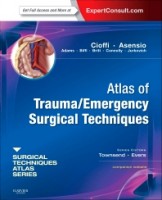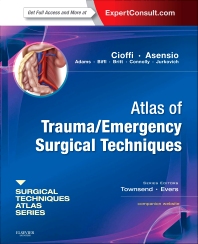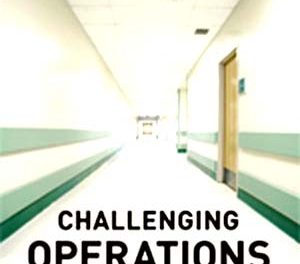 Editors: Charles A. Adams Jr., Juan A. Asensio, Walter L. Biffl, L.D. Britt., William G. Cioffi, and Michael D. Connolly. Gregory J. Jurkovich. Series Editors: Courtney M. Townsend, Jr. and B. Mark Evers
Editors: Charles A. Adams Jr., Juan A. Asensio, Walter L. Biffl, L.D. Britt., William G. Cioffi, and Michael D. Connolly. Gregory J. Jurkovich. Series Editors: Courtney M. Townsend, Jr. and B. Mark Evers
Publisher: Elsevier Saunders – 347 pages
Book Review by: Nano Khilnani
You can study smart with www.ExpertConsult.com. Go to the inside front page of this textbook, scratch off the sticker and get the Activation Code. Then with that code, go and register and activate this title at Expert Consult.
Once you have done this, you can:
• Access the full text online in searchable format through any Internet-ready device, download figures and images, and enjoy additional content. This book will fit in your pocket on a smart phone or tablet, delivering information where and when you need it.
• Search all Expert Consult titles you own.
• Link to PubMed abstracts.
From head to toe, surgeries of various types are covered in this book in full-color visual illustrations and step-by-step instructions.
An overview of the task at hand is written at the beginning of each of its 29 chapters in six sections of the book. To give you an example, in chapter two of Section I entitled Neck Exploration, the author Walter L. Biffl states in the first paragraph: “Most neck injuries requiring operative repair are the result of penetrating trauma. In the setting of stab wounds or low-velocity gunshot wounds, tissue damage is usually confined to the missile track.” And so on…
The chapter then explains the possible scenarios of injury and what needs to be done, in a topic entitled Clinical Anatomy.
On the opposite page is a full-color drawing of the head and neck of the injured patient, with three zones: Zone I below the cricoid cartilage, Zone II between the cricoid cartilage and mandible, and Zone III above the mandible.
In the Clinical Anatomy section, the author explains that the main areas of concern are the carotid and vertebral arteries, jugular veins, the trachea and the esophagus.
This section further explains that the possible areas of impact through stabbing or gunshot include the thoracic inlet, in which the wounds may have injured the brachiocephalic artery, the left common carotid artery, the subclavian artery, as well as various veins and aerodigestive structures. Dr. Biffl states that proximal control of major blood vessels may require a thoracic incision, as shown in chapter 7.
Other areas of concern to the surgeon lie in the posterior of the trachea, beginning at the level of the cricoid cartilage. He points out that the recurrent laryngeal nerves are located in the tracheoesophageal groove and are easily damaged by injury and careless surgical dissection.
A second section entitled Preoperative Considerations follows Clinical Anatomy, with the opposite page showing various blood vessels, muscles and nerves. Bullet points of various items to consider prior to operating on the patient are elaborated on in this section. For example, Dr. Biffl writes at the outset of this section that the initial evaluation should address the all-important ABCs: airway, breathing, and circulation.
A third section entitled Operative Steps follows. Here Dr. Biffl goes into how the various possible surgical procedures should be performed. For example in the first bullet point, he instructs that the patient should be positioned supine. If the injury is expected to be unilateral (only on one side) the head may be turned to the contralateral or other side. But if both sides are to be explored, he advises that the head be maintained in a neutral position. He goes on to present instructions relevant to various other situations in this bullet point and others.
A fourth section entitled Dissection follows. On the opposite page, two figures are presented, with Figure 2-3 exposing the internal anatomy of a section of the neck, and Figure 2-A and 2-B showing arteries and veins within the neck area. In this section are contained detailed surgical procedures in different scenarios.
A fifth section entitled Repairs presents on six pages various illustrations on the right side pages of the internal parts of the neck, and explanations of numerous, detailed, step-by-step surgical procedures on the left pages.
The sixth section is Postoperative Care and the seventh is Perils and Pitfalls. The chapter ends with a list of references entitled Selected Readings.
This book is an easy-to-use guide to various types of surgeries of the human anatomy: head, neck, chest, abdomen (different internal organs) and limbs. There is also a section covering injuries to blood vessels. The student or surgeon can easily find the type of surgery he or she is looking up to read on, by going to the appropriate section, chapter, and pages
With 35 surgeons and professors of surgery from all over the United States as well as Japan and Mexico contributing their expertise to this book on techniques used in emergency rooms, this is a unique and highly valuable reference work for medical students and residents and practitioners in surgery.
It is made even more valuable with the efforts of ten other general surgeons and specialists in various surgical areas, named below, who selected the various procedures to feature in it.
William G. Cioffi and Juan A. Asensio are the main editors of this book, whereas the others performed various other roles in putting together this unique book. Below is some information on their positions in the medical field and what they do:
William G. Cioffi, MD, FACS is Professor and Chairman of the Department of Surgery at The Warren Alpert Medical School at Brown University in Providence, Rhode Island, and Surgeon-in-Chief at Rhode Island Hospital in the same city.
Juan A. Asensio, MD, FACS, FCCM, FRCS (England) is Professor of Surgery and Vice Chairman of the Department of Surgery at New York Medical College. He holds four other positions at Westchester Medical Center University Hospital in Valhalla, New York: Chief of the Division of Trauma Surgery and Acute Care Surgery, Director of the Joel A. Halpern Medical Center, Director of the International Medicine Institute, and Co-Director of the of the Research Institute.
Charles A. Adams, Jr., MD, FACA, FCCM is Associate Professor of Surgery at The Warren Alpert Medical School at Brown University in Providence, Rhode Island. He is also Chief of the Division of Trauma and Surgical Critical Care at Rhode Island Hospital in the same city.
Walter L. Biffl, MD is Associate Director of Surgery and Assistant Director of Patient Safety and Quality at Denver Health Medical Center, and professor of surgery at the University of Colorado in Denver, Colorado.
Michael D. Connolly, MD is Assistant Professor of Surgery at The Warren Alpert Medical School in Providence, Rhode Island. He is also affiliated with the Division of Trauma and Surgical Critical Care at Rhode Island Hospital in the same city.
Gregory J. Jurkovich, MD is Director of Surgery at Denver Health Medical Center. He is also the Bruce M. Rockwell Distinguished Professor and Vice Chairman of the Department of Surgery at the University of Colorado School of Medicine in Denver, Colorado.
L.D. Britt, MD, MPH, DSc (Hon), FACS, FCCM, FRCSEng (Hon), FRCSEd (Hon), FWACS (Hon), FRCSI (Hon), FCS(SA) (Hon) is Brickhouse Professor and Chairman of the Department of Surgery at Eastern Virginia Medical School in Norfolk, Virginia.
Courtney M. Townsend Jr., MD is Professor and John Woods Harris Distinguished Chairman, and Robertson-Poth Distinguished Chair in General Surgery at the Department of Surgery at the University of Texas Medical Branch in Galveston, Texas.
B. Mark Evers, MD is Professor and Vice-Chair for Research at the Department of Surgery, Endowed Chair Director of the Markey Cancer Foundation, and Director of the Markey Cancer Center at the University of Kentucky in Lexington, Kentucky.







